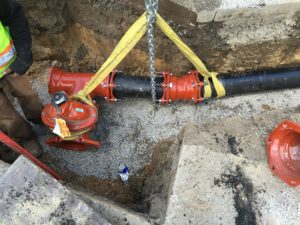Celebrating Silent Infrastructure
 The health of our water systems, electrical grids, cabling, gas lines, sewer pipes and storm drains is critical to our economic vitality and modern society’s ability to function. Infrastructure enables innumerable conveniences such as Netflix binging, washing hands, cooking food, growing crops, heating homes and flushing toilets. We benefit every day at home and work from these modern marvels.
The health of our water systems, electrical grids, cabling, gas lines, sewer pipes and storm drains is critical to our economic vitality and modern society’s ability to function. Infrastructure enables innumerable conveniences such as Netflix binging, washing hands, cooking food, growing crops, heating homes and flushing toilets. We benefit every day at home and work from these modern marvels.
Despite being the underpinning of our modern society, our infrastructure remains an invisible hero in our communities. Often buried along our streets, people have become so accustomed to these services that we rarely give them a second thought. We tend to only notice these services when they become unavailable. Recall, for example, a recent power or Internet outage. Such interruptions to our lives are the rare instances when we become fully aware of our dependence on electricity. Similarly, when our water systems fail and we are unable to take a hot shower before work or after a workout, we become hyperaware of the gift of running water.
And while we take this infrastructure for granted in most of the U.S. (Flint, Michigan comes to mind as a place where they don’t have that luxury), others can’t. As described by the Los Angeles Times, several communities in Mexico currently live without consistent electricity, water and other services due to unfinished electrical grids, water systems and other infrastructure. In these communities, lack of proper services is due to a variety of failed investments. Creating good infrastructure is not magic–it takes hard work, major investments and consistent execution and the examples from Mexico’s experiments with state-funded neighborhoods should remind us all of that.
Public infrastructure investment is mostly funded by residents’ contributions through taxation, fees, use fees (rates), grants (usually state or federal tax dollars returned to the cities), fines and special assessments. But when you ask an average person about funding for the topic, they may be confused or unaware of their contributions. Local governments have an obligation to communicate with their constituents about investments in infrastructure that allow their community to prosper. We urge that cities make silent infrastructure less silent, and instead provide visuals, explanations and celebratory milestones when infrastructure is built, updated or provided.
Here are four simple ways to do just that:
1. Show Developments in Realtime
Feature work crews in photography as they are replacing pipes or fixing up a sewer system, or share a cool timelapse video of the project work.
2. Leverage Metrics
If your agency does a yearly summary of key metrics, try including “gallons of water delivered” or “miles of pipe that have been upgraded.”
3. Provide Index Report Details
Cities are pretty good about highlighting their pavement index and talking about their street conditions. With streets, the public can see the current state of affairs. They can’t see what is underground. So, make sure you provide some index report to address the condition of pipes in the ground.
4. Partner with Utilities
Partner with your local gas and electric utility or utilities to share in building out new substations or distribution services. Even if it is not your agency’s infrastructure, you were a partner in helping the utility implement it, and your city is still likely to get phone calls when the power goes out.


